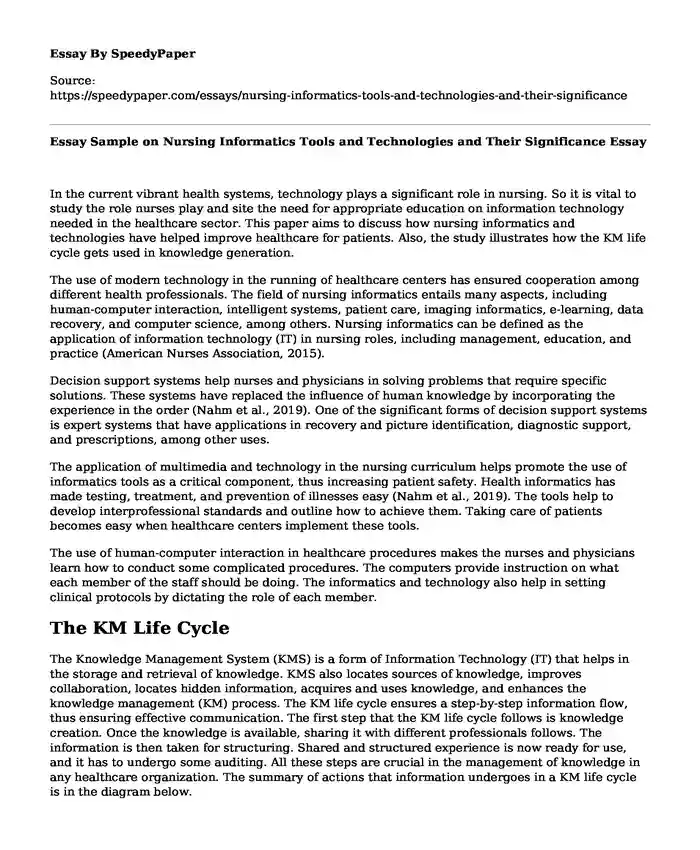
| Type of paper: | Essay |
| Categories: | Knowledge Nursing Information technologies Professional development |
| Pages: | 3 |
| Wordcount: | 718 words |
In the current vibrant health systems, technology plays a significant role in nursing. So it is vital to study the role nurses play and site the need for appropriate education on information technology needed in the healthcare sector. This paper aims to discuss how nursing informatics and technologies have helped improve healthcare for patients. Also, the study illustrates how the KM life cycle gets used in knowledge generation.
The use of modern technology in the running of healthcare centers has ensured cooperation among different health professionals. The field of nursing informatics entails many aspects, including human-computer interaction, intelligent systems, patient care, imaging informatics, e-learning, data recovery, and computer science, among others. Nursing informatics can be defined as the application of information technology (IT) in nursing roles, including management, education, and practice (American Nurses Association, 2015).
Decision support systems help nurses and physicians in solving problems that require specific solutions. These systems have replaced the influence of human knowledge by incorporating the experience in the order (Nahm et al., 2019). One of the significant forms of decision support systems is expert systems that have applications in recovery and picture identification, diagnostic support, and prescriptions, among other uses.
The application of multimedia and technology in the nursing curriculum helps promote the use of informatics tools as a critical component, thus increasing patient safety. Health informatics has made testing, treatment, and prevention of illnesses easy (Nahm et al., 2019). The tools help to develop interprofessional standards and outline how to achieve them. Taking care of patients becomes easy when healthcare centers implement these tools.
The use of human-computer interaction in healthcare procedures makes the nurses and physicians learn how to conduct some complicated procedures. The computers provide instruction on what each member of the staff should be doing. The informatics and technology also help in setting clinical protocols by dictating the role of each member.
The KM Life Cycle
The Knowledge Management System (KMS) is a form of Information Technology (IT) that helps in the storage and retrieval of knowledge. KMS also locates sources of knowledge, improves collaboration, locates hidden information, acquires and uses knowledge, and enhances the knowledge management (KM) process. The KM life cycle ensures a step-by-step information flow, thus ensuring effective communication. The first step that the KM life cycle follows is knowledge creation. Once the knowledge is available, sharing it with different professionals follows. The information is then taken for structuring. Shared and structured experience is now ready for use, and it has to undergo some auditing. All these steps are crucial in the management of knowledge in any healthcare organization. The summary of actions that information undergoes in a KM life cycle is in the diagram below.
Nurses are inter-professional collaborators as they work with all departments of the healthcare organization to ensure that the patients receive care. It is a nurse who manages and administers prescriptions that a doctor issues (Lobach et al., 2017). Also, a nurse helps the patients interpret doctors' prescriptions and, therefore, helps them fit in the KM system. The nurses must work in collaboration with physicians to give the patients treatment. The nurses also collaborate with the laboratory department to link the patients with the department to help them.
Nurses help other practitioners to acquire patient data to use in taking care of the patient. It is a nurse who assesses the patient and collects background facts about the patient for treatment, diagnosis, and care (Lobach et al., 2017). Once the nurses have the information, they forward it to the doctors and therapists for patient diagnosis and treatment.
It is also the responsibility of a nurse to coordinate with general healthcare staff to ensure that patients receive auxiliary services like laundry and meals. The nurse serves as a link between all departments of a healthcare system to communicate and transfer information successfully.
References
American Nurses Association. (2015). Nursing informatics: scope and standards of practice.
Lobach, D., Sanders, G. D., Bright, T. J., Wong, A., Dhurjati, R., Bristow, E., ... & Williams, J. W. (2017). Enabling health care decision-making through clinical decision support and knowledge management. Evid Rep Technol Assess (Full Rep), 203(203), 1-784.
Nahm, E.-S., Poe, S., Lacey, D., Lardner, M., Castle, B. V. D., & Powell, K. (2019). Cybersecurity Essentials for Nursing Informaticists. CIN: Computers, Informatics, Nursing, 37(8), 389–393. https://doi.org/10.1097/cin.0000000000000570
Cite this page
Essay Sample on Nursing Informatics Tools and Technologies and Their Significance. (2023, Oct 11). Retrieved from https://speedypaper.com/essays/nursing-informatics-tools-and-technologies-and-their-significance
Request Removal
If you are the original author of this essay and no longer wish to have it published on the SpeedyPaper website, please click below to request its removal:
- Free essay sample for students: Juan Mata's blog analysis
- Free Essay Sample: Effects of Channel on Learning
- Essay Sample on Maternity Case Study
- Paper Example on Having Computers in the Classroom is Beneficial to Students
- Essay Example. Student Self-Assessment
- Free Paper: Infant Self-Regulation and Early Childhood Media Exposure
- Tools and Techniques Learned - Essay Sample
Popular categories




